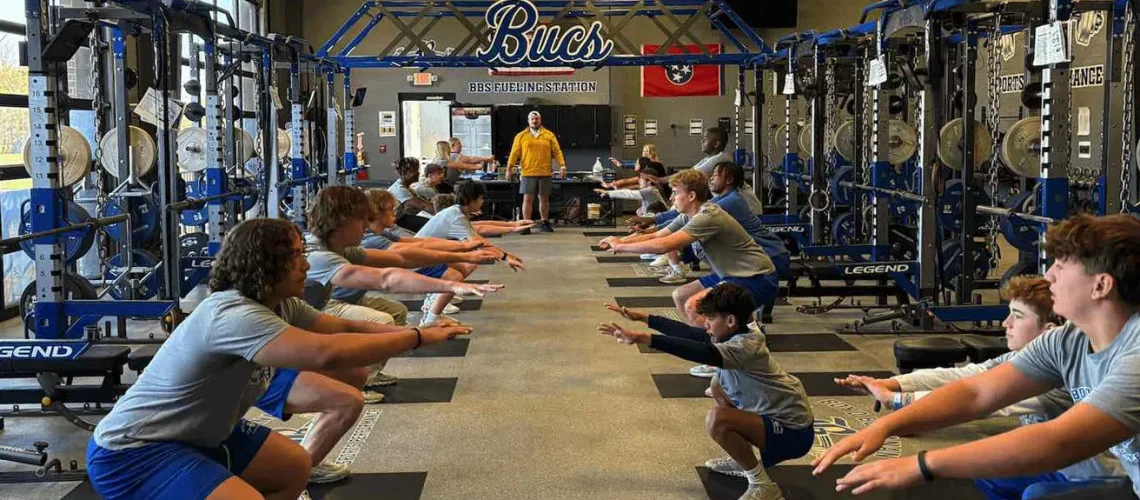A Small School Approach to the Start of the LTAD Process
By J.T. Rankin, NHSSCA HSSCC, CSCS, USAW
Introduction: Building Strong Foundations for Long-Term Athletic Success
Long-Term Athletic Development (LTAD) is more than just a buzzword—it’s a guiding philosophy for helping young athletes build the physical literacy, movement skills, and confidence necessary for lifelong athletic potential.
While the underlying themes of LTAD programs are often similar, each implementation must be tailored to the school setting, resources, and staffing. And while high school is a logical starting point, the true power of LTAD comes alive when its principles are introduced earlier—ideally in middle school or even elementary PE classes.
This article offers a practical look at how we’ve structured an LTAD-based approach at our small private school, with a special focus on training at the later middle school level.
Logistics Matter: The Key to Making LTAD Work
I’m currently in my seventh year as the Strength & Conditioning Director at a small private school serving under 400 high school students. Across two schools and three academic schedule structures, I’ve implemented a variety of in-school and after-school models for youth training.

From hands-on coaching to hybrid scheduling, programming for athlete-only sessions to mixed general population PE, the one constant has been change. Every year presents a new logistical challenge—but adaptability is what keeps the program growing.
Key Takeaway: Stay flexible. Build systems that serve your students, not the other way around.
Our Current Strength & Conditioning Schedule (Grades 6–12)
To give context to our LTAD roadmap, here’s how we’ve structured training across grades:
- After-School: Reserved for high school sport-specific sessions and our Youth Fitness program (Grades 4–6).
- During the School Day: Middle school S&C is embedded into PE classes, allowing us to reach every student and ensure consistency.
I work closely with our middle school PE instructor to ensure vertical alignment between our middle and upper school programs.

Grade-by-Grade LTAD Progression
- 6th Grade:
9-week “Intro to S&C” module
Focuses on dynamic warm-ups, mobility, coordination drills, basic plyometrics, intro speed training, and light resistance work (bands, med balls, light kettlebells). - 7th Grade:
Semester-long course
Builds upon 6th-grade content with added volume, variety, and progressions in movement competency. - 8th Grade:
Full-year “Strength & Conditioning” course
Serves as our “Block 0” for entry into the high school program. Students begin training with barbells and mastering foundational lifts.

8th Grade in Action: Sample Program Design
Assuming prior development in movement quality, our 8th-grade students train 3x/week using the following structure:
Weekly Layout:
- Day 1: Core | Hang Clean | Back Squat | Push Press | Pull-Up | Push-Up | Ring Row
- Day 2: Core | KB Swing | Trap Bar DL | Bench Press | DB Row | Lat Pulldown | SA Overhead Press
- Day 3: Core | Hang Snatch | Front Squat | Overhead Press | Pull-Up | DB Bench | Inverted Row
Set & Rep Scheme:
- Primary lifts: 3–4 sets x 3–6 reps
- Accessory lifts: 3–4 sets x 8–12 reps
Schedule Notes:
- Training blocks take place when the high school weight room is available (during study hall, chapel, or activity blocks).
- One academic rotation day is used for speed & agility training.
- One “off” day is built into the academic week.
Keeping It Fun and Functional: Game Days
Every 3–4 weeks, we hold “game days” to build athleticism in a fun, low-pressure format. These include:
- Agility ladder & coordination circuits
- Sprint mechanics
- Extensive/intensive plyometrics
- Change-of-direction & transition drills
These days not only keep students engaged but also reinforce real-world movement patterns in a playful setting.
Final Thoughts: Keys to Early LTAD Success
Whether you’re just starting your LTAD program or refining an existing one, remember these guiding principles:
- Simplicity and consistency outweigh complexity and novelty early on.
- Progress only when ready—don’t rush students into advanced movements before mastering the basics.
- Train with a long view—think about where you want these kids to be four years from now, not just in the next eight weeks.
When done well, an LTAD approach empowers students to build confidence, stay injury-free, and develop lifelong skills that extend far beyond the field or court.
J.T. Rankin has been serving as a Strength and Conditioning Director for grades 6-12 for over 7 years and is currently the Physical Education Department Head and Director of Sports Performance for Boyd Buchanan School. JT is certified through the NHSSCA (HSSCC), NSCA (CSCS), and USA Weightlifting (USAW), along with having a Master’s Degree in Exercise Science. Coach Rankin also serves on the State Advisory Board of the NHSSCA for the state of Tennessee.


